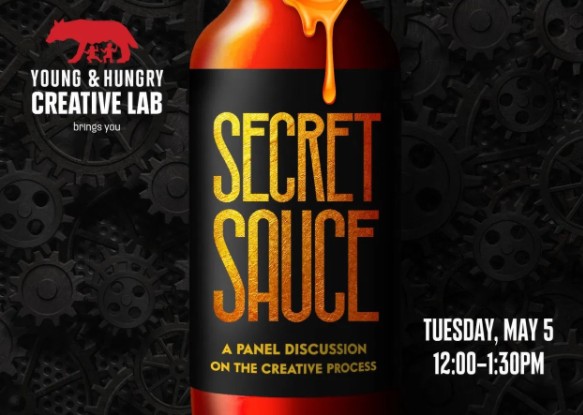By Nina Tabios
In the 2008 animated film “Kung Fu Panda,” the character Po mulls over his father’s special soup. The panda, who struggled with self-acceptance, seeks its secret ingredient: the thing that makes it special. It isn’t until after he becomes a martial arts master—and defeats a prophecy-seeking snow leopard—when he realizes the answer has been spoon-fed to him all along: “There is no secret ingredient.” The soup was special simply because he believed it was.
During “Secret Sauce,” a recent panel hosted by the School of Advertising’s (ADV) Young & Hungry Creative Lab, a group of Academy of Art University alumni discussed creativity. However, their advice and message to students offered a similar epiphany to the one Po experienced.
“Don’t forget, what makes you important in the design industry, in the creative industry, is your uniqueness,” said Art Director and ADV alumna Alexandra Camancho (B.F.A. 2015) during the Zoom event on the afternoon of Tuesday, May 5. “It’s the fact that what you can provide no one else can.”
Camancho was joined by five other Academy alumni, each bringing their own unique backgrounds and experiences with creativity to the panel. Conor Rechtschaffner (B.F.A. 2013) is an art director at Twitter’s in-house creative studio; Enes Olcay (M.F.A. 2017) is a UX designer for Volkswagen; Khai Pham, who earned a bachelor’s degree in advertising before graduating with a master’s in web design in 2017, is a product designer for Wealthfront, a Fintech company; Victoria Inoue (M.F.A. 2016) is a copywriter for startup company Molekule; Mina Huei Lu (M.F.A. 2019) is a graphic designer producing branding for Gong Cha, a global Taiwanese bubble tea brand.
The talk was moderated by James Wojtowicz, Young & Hungry creative director and ADV director of art direction and industry development. He asked the panelists about their creative process and what they’ve learned about creativity since they started in the workforce.
“What is the first thing you do when you receive a creative brief?” he asked.
Inoue starts by just letting ideas flow. “It’s been good for some of my projects to just go into writing. Seeing too much research can taint or drive my ideas into one direction,” she explained. “I want to react creatively and from the gut, then see if it magnetizes to the brief.”
As a designer, Olcay first searches for the humanness in the problem, to draw from real user needs and design around emotions. Rechtschaffner, who likens his work to storytelling, agreed.
“Advertising is trying to find human connection, [a] bigger story that really relates,” he said. “What’s the thing that’s going to connect you to that product? That thing. Finding that human truth.”
Wojtowicz then pivoted to other common occurrences in the creative process: getting stuck and working with a partner.
When it comes to creative blocks, Inoue said the more ideas the better. “Volume,” she responded. “Writing hundreds of things because the first 99 aren’t going to be good. You have to get all the bad stuff out before the good thing comes.”
Pham, a designer whose own process is predicated on “connecting the dots,” recalled how crucial collaboration is in his line of work. Good partners, he said, need the ability and will to listen and cooperate as a collective.
“Working through a problem is a multi-player game. You have to include people in the process,” he said. Being able to bounce ideas around is just one part of it. “Having empathy for your teammates allows you to drop your guard, to trust them and open up.”
Following the panel, students typed their questions in the chat. One student, Zheng Wei, asked how to cut ideas and pick the best one to design.
Inoue replied that the coolest ideas don’t always work best. There are a ton of factors to consider: What would appeal to consumers? What’s fun? What’s creative? How will it affect a bigger campaign? Or, does it make sense for the brand and its stakeholders?
“Be okay with killing your darlings because that’s going to happen all the time,” Inoue said.
“What is your worst idea ever pitched?” ADV Co-Director Andrea Pimentel asked the panelists. Olcay mentioned when an idea he pitched for Porsche was met with a negative response–the experience was a lesson in how to advocate for his ideas, but to also get comfortable with failure. As Wojtowicz put it, failure is something future creatives need to get used to and not be afraid of.
“That question was a direct torpedo to share your story of failure which is part of the whole process,” he said. “It’s not being afraid to fail swinging for the fences.”
By the end of the talk, the secret to creativity seemed clear: there isn’t one. More so, it’s about buying into your own creativity and building the skillset to put the best work forward.
“Everyone has, along the way, learned from other people little tips and tricks that can help you think innovatively and think beyond the obvious answer,” Wojtowicz said. “It’s a process and the more you do it, the better you get at it. Creativity is a muscle; you have to use it and work it out. And the results show.”
